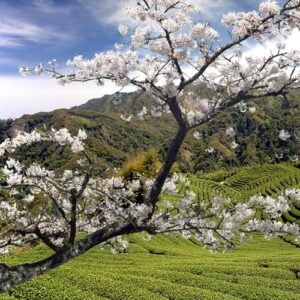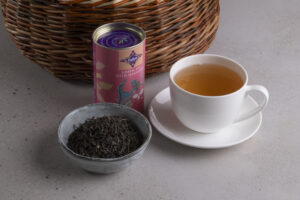Your basket is currently empty!
Introduction to Oolong Teas

Introduction to Oolong Teas: complex semi-oxidized teas
Oolong teas, or wulong as they were known, translates as Black Dragon and these teas account for around fourteen percent of Chinese tea production. Highly acclaimed in China, they are semi-fermented, in that the leaf is partially oxidised and therefore lye between green tea which is not oxidised and black tea which is fully oxidised. In this introduction to Oolong teas it should be pointed out that these teas are the most difficult type to manufacture. Depending upon the particular variety there can be as few as three steps in the making of oolong to as many as eighteen and each must be carefully controlled. Oolong teas are made from larger leaves and may be picked as a set of the top three leaves. They are picked after the green leaf, during the middle of the day.
Where oolong teas are produced
Oolongs have a more complex flavour than either green or black teas and this explains their increasing popularity. Many of the best oolongs are from Taiwan, Formosa as it used to be known. Fujian Province in mainland China also produces high quality and indeed famous oolong teas.
China Oolongs
It was from this thickly vegetated area of mountainous limestone, the Wuyi Shan in the north-west of the province that the tea bushes of the genus Camellia sinensis originated. The ground is enveloped in thick cloud which makes the whole character of this tea producing entirely unique. This small area of less than forty square miles forms one of the ‘routes of tea enlightenment’ for those exploring the way of Chinese tea and it has nourished the thirst and minds of writers, artists, monks and hermits for centuries. Teas from the Wuyi Shan, such as the famous Da Hong Pao (Royal Red Robe), are known as Ming Yan teas. Those from outside the Wuyi Shan are known as Dan Yan teas. Northern Fujian, Min-Bei, produces large open style oolongs noted for their richness and deep flavour. Further south, Min-Nan, produces rolled styles such as Ti Kuan Yin (Iron Goddess of Mercy oolong) famously from the Anxi region of southern Fujian Province. Since the Qing dynasty this has been nominated a Tribute tea (now known in China as a Famous Tea). The leaf is plucked from tieguanyin cultivar. Oolongs from southern Fujian Province tend to be greener and are noted for their fragrance. Guangdong Province, also in the South East China produces the famous Dan Cong oolong from Phoenix Mountain. The leaf is gathered from cultivars trained to the size of trees created from trees 200 to 600 years old.
Formosa oolongs
Most oolongs from Taiwan come from the central, mountainous region. Styles of Formosa oolongs are many and varied ranging from tightly rolled to loosely rolled and curled. Famous Dong Ding (Tung Ting) oolong comes from Nantou County and its spring picking has a full flavour. Oriental Beauty (Bai Hao) oolong is highly oxidised and is noted for its character formed from enzymes turning the edges of the leaf white. It is principally produced in northern Hsinchu County. Oolongs produced in the Alishan mountains of the south are lightly oxidised giving them a natural sweetness.
How oolong tea is made
As an introduction to oolong teas, production firstly involves withering of the picked leaf in direct sunlight followed by shaking or rolling of the leaf over a period of between six and eight hours to bruise the leaf edges. The leaf is then more vigorously tumbled in a bamboo drum three times for about twenty minutes each time over a period of six hours. It is this bruising that allows the juices to come out of the leaf which gradually turn a reddish colour. Typically Formosa Oolongs are fermented 60-70%, closer to black teas, whereas China oolongs are generally fermented only 12-20% and are therefore closer to green teas. They are also greener in appearance. The tumbled leaf is then fired on wire racks in, traditionally, charcoal ovens at about 40 degrees centigrade for around two hours. A final firing four six hours finishes the tea. The appearance of the leaf will be either open, crimped or ball rolled, the colour varying from greenish-grey to brownish-black.
How to make your pot of oolong tea
Oolongs should be made with fresh boiling water as used for black tea. The tea should be infused for between five and seven minutes. Oolongs may be brewed repeatedly but the length of infusion will need to be gradually increased. This method is known as gongfu and requires a small earthen wear Yixing teapot which is filled completely with leaf and then infused six to eight times. The oolongs from southern Fujian province, being rolled can be infused for a greater number of times and in fact need several infusions for the leaf to fully unfurl and release the full complexity of flavour.
The liquor should appear greenish orange for China oolongs and golden brown for the more oxidised Formosa oolongs. For the more fully oxidised oolongs the taste will tend to be richer and mellow with flavour of honey, leather and sandalwood. The less oxidised, greener oolongs will be fresher, of peaches and apricots as well as being more flowery. The finish is generally long and sweet and the aroma is aromatic and floral. Oolongs are especially suitable for drinking with savoury foods such as fish, poultry and spicy foods. They should be drunk without milk.
Goddess of Mercy Oolong
Ti Kuan Yin, from southern Fujian Province is legendary amongst lovers of oolong teas. Goddess of Mercy was chosen in the 17th-18th century by the Qing Dynasty emperor, Qianlong, as one of his tribute teas. It is highly regarded for the fragrance of the picked leaf, its lasting flavour on repeat infusions and the aroma of the finished tea. Ti Kuan Yin is picked from distinctive varieties of tea bush around twenty seven villages surrounding Anxi, which is itself synonymous with the tea.
There are three types of this revered tea: clear and fragrant – with a herbaceous style due to being fired at a lower temperature; traditional – which is sweet without astringency and wild – which produces a fruity, leathery flavour with a heady aroma. A good Ti Kuan Yin should show infused leaves that have a lovely reddish brown colour and brighter, crimson edges gained through bruising of the leaf in manufacture.
The Character of Oolong Teas
From Formosa, silver-tip oolong is a lovely heady aroma and clean taste of stone fruit. The liquor in the cup is clear and golden. The large open style of leaf enables it to be infused several times.
Oolongs from Sri Lanka and Darjeeling: the varieties of tea bush, terrain, climate and skills of the workforce do not lend themselves towards the production of oolongs with the subtlety and complexity of those from China and Taiwan.
Some oolongs can be bought flavoured and orange blossom oolong is a popular and traditional variety.
Do explore the huge variety of these beautiful and complex teas. They do demonstrate to perfection the true skill of the tea maker in being able to produce a variety of styles each with a keen following of their own. To think too of the stunning and far away landscapes in which they are produced only adds to the intriguing of these fabulous, little known teas.
See our the oolong teas section of our tea store.


